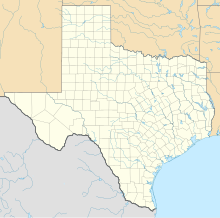Buttermilk Creek Complex
Coordinates: 30 ° 54 '12.3 " N , 97 ° 39' 57.5" W.
As Buttermilk Creek Complex ( dt. Buttermilk Creek Complex ) is an archaeological treasure horizon from the Paleo-Indian period along a dry Buttermilk Creek , southwest of Belton in Bell County ( Texas called), from which the previously oldest evidence of human in 2011 settlement of America have been published . The Debra L. Friedkin Site is only around 250 m from the Gault Site, known since 1929, of the Clovis culture . The layer known as Buttermilk Creek Complex is stratigraphically deposited directly under a layer of the Clovis culture. The long popular “Clovis First Theory” has now been refuted in a direct stratigraphic sequence of layers.
The found-bearing layer was dated to an age between 15,500 and 13,200 years Before Present using optically stimulated luminescence (OSL) . The 18 data were measured on quartz from these sediments; the stated age range represents the minimum age of the samples. Even if systematic measurement errors are included, the finds are before the Clovis culture.
Finds
The Buttermilk Creek is characterized by the fact that its course follows an outcrop of Edwards Chert , a flint particularly suitable for the production of stone tools . The excavations were started in 2006 by a team led by archaeologist Michael Waters from Texas A&M University . The stone tools found since then include 56 pieces of equipment ( retouched artifacts ), hundreds of chips, and thousands of manufacturing scraps. The total of 15,528 stone artifacts all but one consist of “ chert ” (fine-grained flint) from the nearby Edwards Plateau . The exception is a partially polished piece of hematite . They were found embedded in a 20 cm thick layer in clay sediments of the dry stream bed, which lay under a thin, 2.5 cm thick layer of artifacts from the Clovis culture.
Among the finds are twelve finished, started and broken projectile points with edges retouched on both sides , but still without the surface retouching characteristic of Clovis points. In no case is the basal scarfing groove of the “fluted points” that is characteristic of Clovis . From this it is concluded that this is a forerunner of the Clovis culture. After immigration over the Beringia land bridge at the end of the Wisconsin Glaciation (the last glaciation in North America), the Clovis culture with the typical fluted points was not brought from Asia, but developed from the Buttermilk Creek Complex south of the large Laurentide ice sheet . This corresponds to the fact that all the fluted points found in Alaska are significantly younger. With the data from the Debra L. Friedkin Site , there is “a generous amount of time” for people to “immerse themselves in the North American environment, colonize South America, develop the Clovis tools, and create a population base in which the Clovis can find themselves -Technology could spread. "
Other artifacts included blades and a core , the shape of which was created when finer tools were chipped from a block of stone.
A detailed analysis compared the finds from the Buttermilk Creek Complex with the Clovis layer directly above it at the same site and the Clovis finds at the neighboring Gault site. It was found that the type and frequency of stone tools and the splinters produced during processing are closely related to the nearby Clovis finds, but also show statistically significant differences. This refuted theses that criticized after the first publication in 2011 that the Buttermilk Creek Complex had been classified incorrectly. The finds are not about a tool culture before Clovis, but about Clovis finds that were transported into deeper layers due to the special conditions in the local Vertisol soil. This suspicion could be dispelled. Rather, the relationship between the BCC and the Clovis finds of the immediate vicinity corresponds exactly to what one can expect when one culture evolves into a later one.
rating
The Buttermilk Creek Complex is remarkable because of the very consistent data set for the OSL method. If the data are classified as relevant, they are also older than the age of the pre-Clovis finds from the Paisley Caves in Oregon with an age of 14,300 years BP, Meadowcroft in Pennsylvania (14,555-13,955 cal BP) or determined by means of radiocarbon dating the location Monte Verde in Chile (14,000 to 12,000 BP), which the Buttermilk Creek Complex would make the previously oldest archaeological horizon America.
However, according to a statement by expert Gary Haynes ( University of Nevada ) for Science magazine , radiocarbon dates would be important to gain certainty about pre-Clovis dating.
Individual evidence
- ↑ a b c d e Michael R. Waters et al .: The Buttermilk Creek Complex and the Origins of Clovis at the Debra L. Friedkin Site, Texas (PDF; 990 kB) . In: Science , Volume 331, March 25, 2011, pp. 1599–1603 doi : 10.1126 / science.1201855
- ↑ Eliot Marshall: Clovis First. Science Vol. 291, no. 5509, 2001, p. 1732 doi : 10.1126 / science.291.5509.1732
- ^ A b Heather Pringle: Texas Site Confirms Pre-Clovis Settlement of the Americas. Science Vol. 331 no. 6024, 2011, p. 1512 doi : 10.1126 / science.331.6024.1512
- ^ Paul Rincon, Jonathan Amos: Stone tools 'demand new American story'. BBC News (accessed March 26, 2011)
- ↑ a b c Thomas A. Jennings, Michael R. Waters: Pre-Clovis lithic technology at the Debra L. Friedkin site, Texas: comparisons to Clovis through site-level behavior, technological trait-list, and cladistic analyzes . In: American Antiquity , Volume 79 (2014), pages 25-44
- ^ New York Times: Arrowheads Found in Texas Dial Back Arrival of Humans in America , March 25, 2011, A14
- ↑ Juliet E. Morrow, Stuart J. Fiedel, et al .: Pre-Clovis in Texas? A critical assessment of the "Buttermilk Creek Complex" . In: Journal of Archaeological Science , Volume 39, Issue 12, (December 2012), pages 3677-3682, doi: 10.1016 / j.jas.2012.05.018
